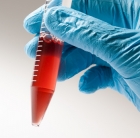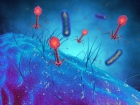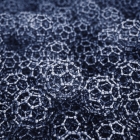Press monitoring
A fire brigade against mosquitoes: New technology can protect against the spread of tropical diseases
5.6.2023 | Press monitoring
In an article published in the journal Biotechnology Advances, a consortium of researchers from Frankfurt and Giessen at the LOEWE Center TBG shows a way out of this dilemma between nature and health protection with a new technology they have developed. Their common goal is to build a kind of fire brigade against tropical diseases transmitted by...
Engineering the bacteriophage T4 to serve as a vector for molecular repair
2.6.2023 | Press monitoring
A team of medical scientists at The Catholic University of America, in Washington, D.C., working with a colleague from Purdue University, has developed a way to engineer the bacteriophage T4 to serve as a vector for molecular repair. Prior research has shown that many human ailments arise due to genetic mutations: cystic fibrosis, Down syndrome,...
New 3D stretchable electronics can advance organ-on-chip technology
31.5.2023 | Press monitoring
Engineers from UNSW Sydney have discovered a way to create flexible electronic systems on ultra-thin skin-like materials. Flexible electronic nanomembranes show promise for revolutionary organ-on-chip technologies, potentially reducing the need for animal testing in medical research. The development allows entire stretchable 3D structures to...
Japanese researchers successfully induce primate oocytes in the lab
29.5.2023 | Press monitoring
The many types of cells in the human body are produced through the process of differentiation, in which stem cells are converted to more specialized types. Currently, it is challenging for researchers to control the differentiation of stem cells in the lab (in vitro). Of particular interest are oocytes, which are female germ cells that develop...
Bioprospecting technique uncovers viruses that can kill deadly superbugs
26.5.2023 | Press monitoring
In a modern take on the Victorian gold rush, a Monash University-led project is successfully "bioprospecting" for viruses known as phages that can kill deadly superbugs. The Monash Biomedicine Discovery Institute (BDI) team, led by Dr. Rhys Dunstan and Professor Trevor Lithgow of the Bacterial Cell Biology Laboratory, has had some success in...
Finally delicious: New proteins to revolutionize gluten-free baked goods
24.5.2023 | Press monitoring
Gluten is one of the largest natural proteins and has fantastic properties: It keeps a well-cooked dough airy until baking stabilizes the open-pore structure. Prof. Dr. Mario Jekle from the University of Hohenheim in Stuttgart is working on processes in which selected proteins from peas, rapeseed, rice, or maize, for example, directly replace...
Human trial of mRNA universal flu vaccine begins
22.5.2023 | Press monitoring
It’s still very early days, but the race to develop the first safe and effective mRNA-based influenza vaccine is gathering momentum. The latest move sees a Phase 1 trial at Duke University in Durham, North Carolina, get under way, testing the safety and immune response of H1ssF-3928 mRNA-LNP, developed by the National Institute of Allergy and...
Plastic-eating fungi thriving in man-made plastisphere may help tackle global waste
19.5.2023 | Press monitoring
A new study published in the Journal of Hazardous Materials by researchers at the Royal Botanic Gardens, Kew, and partners has identified a diverse microbiome of plastic-degrading fungi and bacteria in the coastal salt marshes of Jiangsu, China. The international team of scientists counted a total of 184 fungal and 55 bacterial strains capable of...
Biodegradable nanoscavengers can reverse insulin resistance in liver cells to treat type 2 diabetes
17.5.2023 | Press monitoring
Although diabetes is a common condition, no cure exists yet. Current therapies can manage blood sugar levels, but they do not address insulin resistance. But now, recent research reported in ACS Nano shows that targeting certain highly reactive molecules in the liver can reverse insulin resistance in human liver cells and diabetic mice, providing...
Fighting oral bacteria is elementary with SHERLOCK-based detection tool
15.5.2023 | Press monitoring
Thanks to a novel tool that detects bacteria in saliva using SHERLOCK, the evolution of CRISPR, you may soon be able to leave the dentist after a checkup with more comprehensive information about the health of your mouth. The accurate tool is much faster than existing methods and may lead to the early detection and treatment of mouth and other...
































